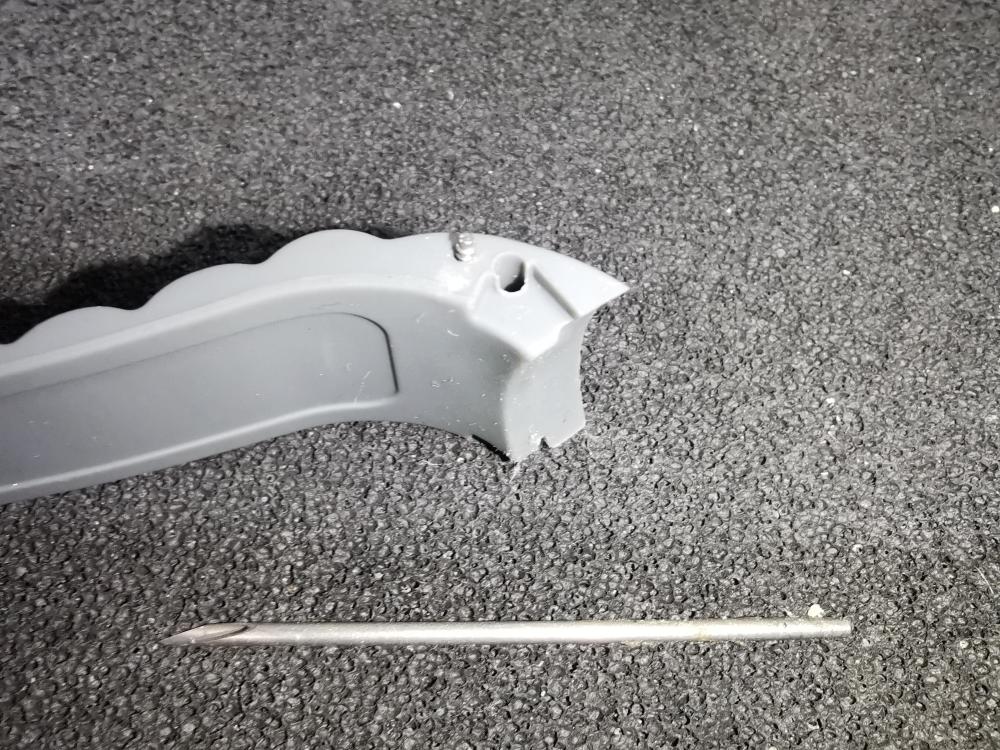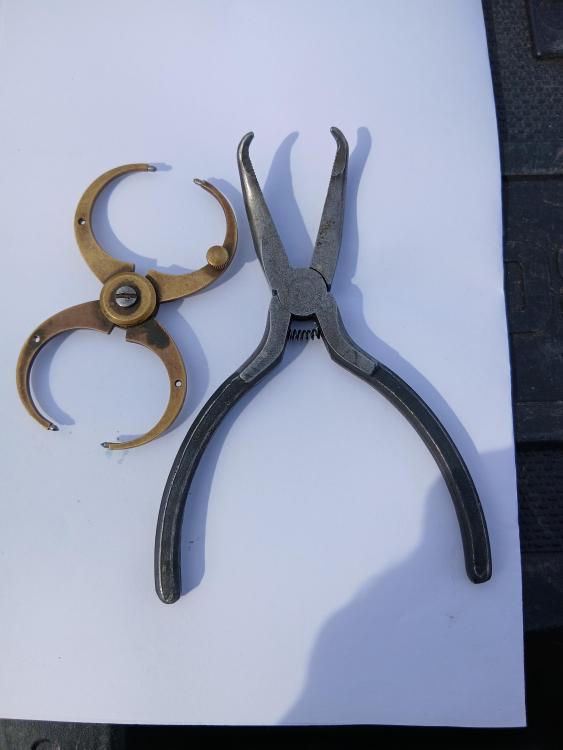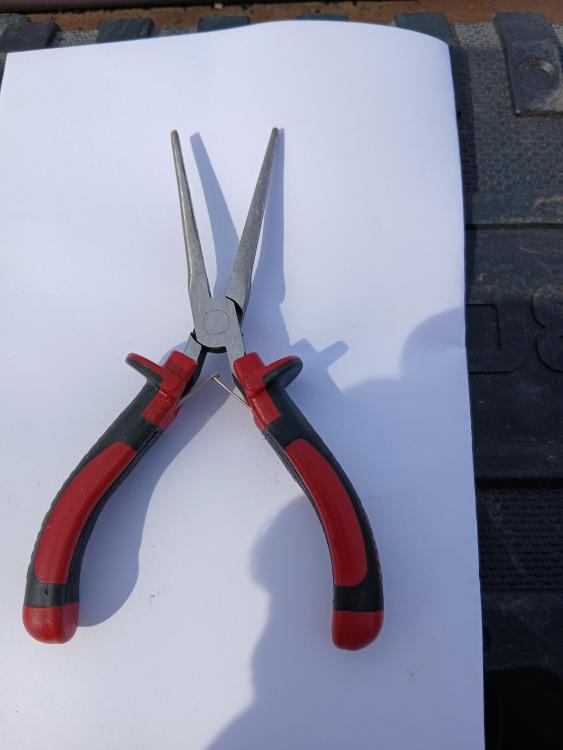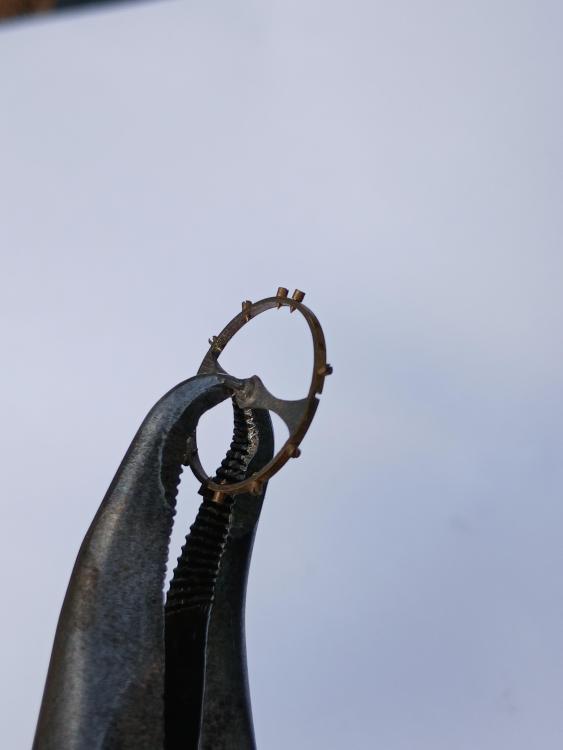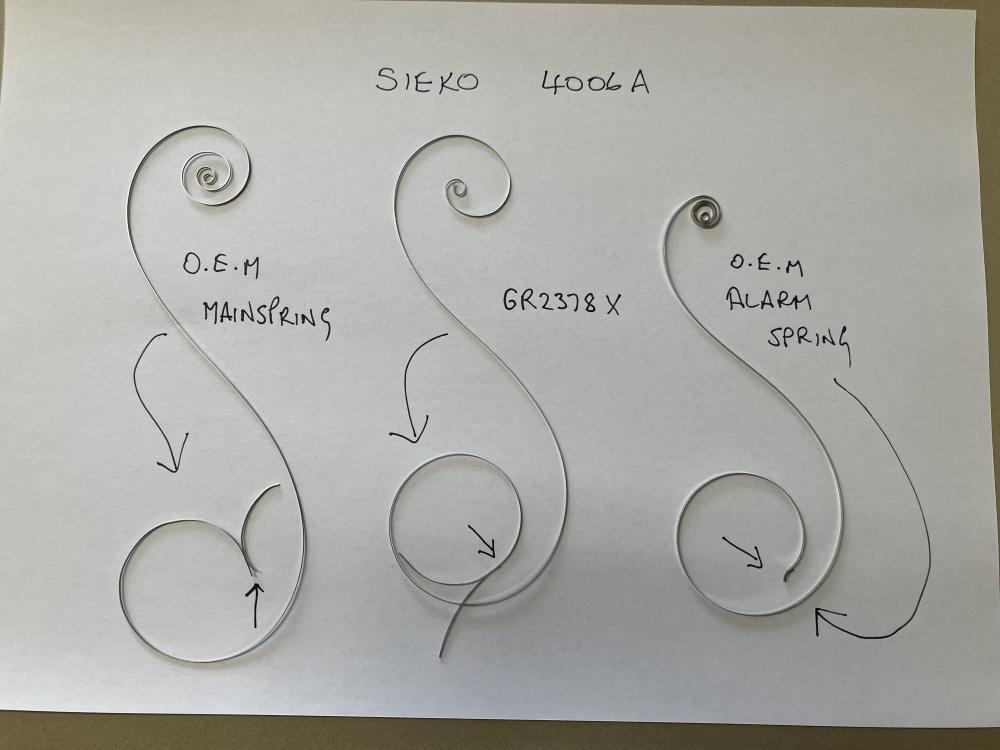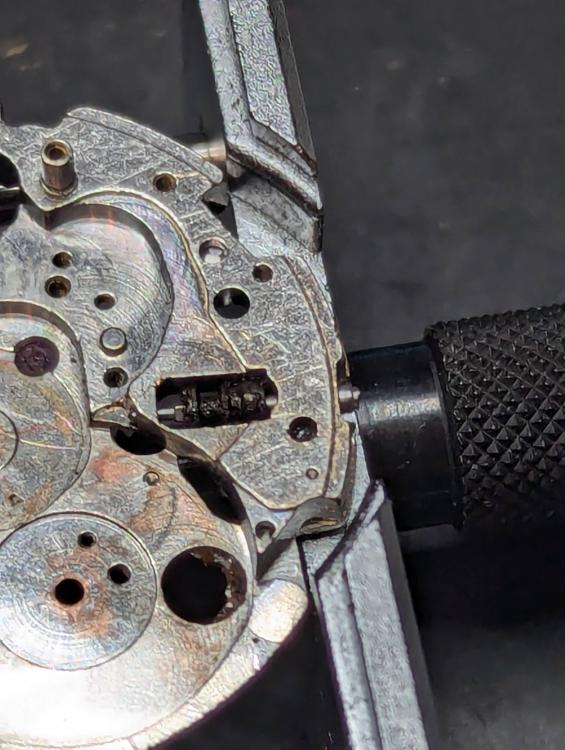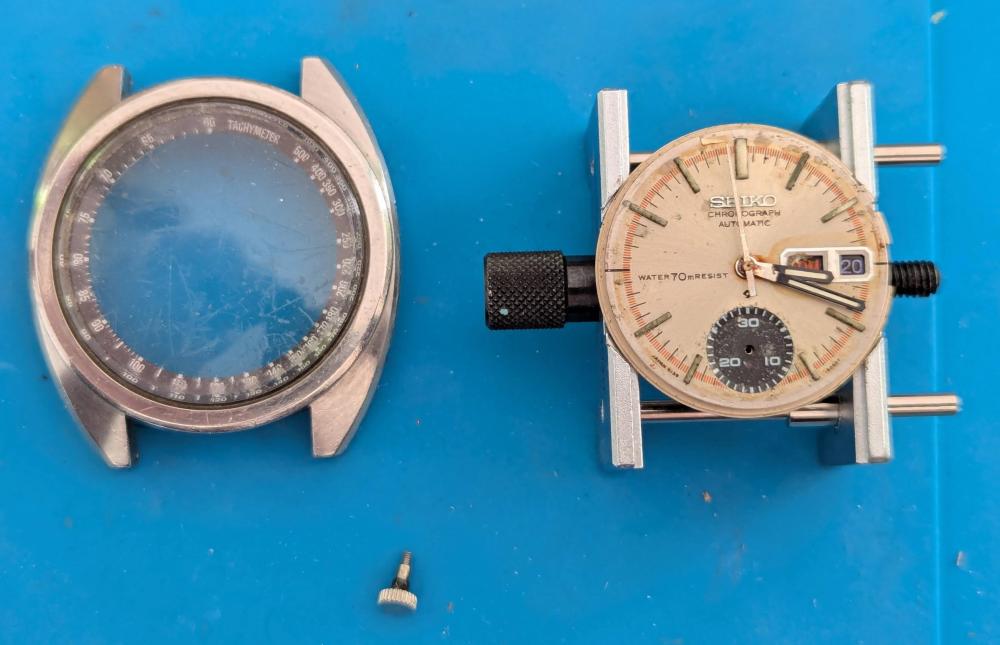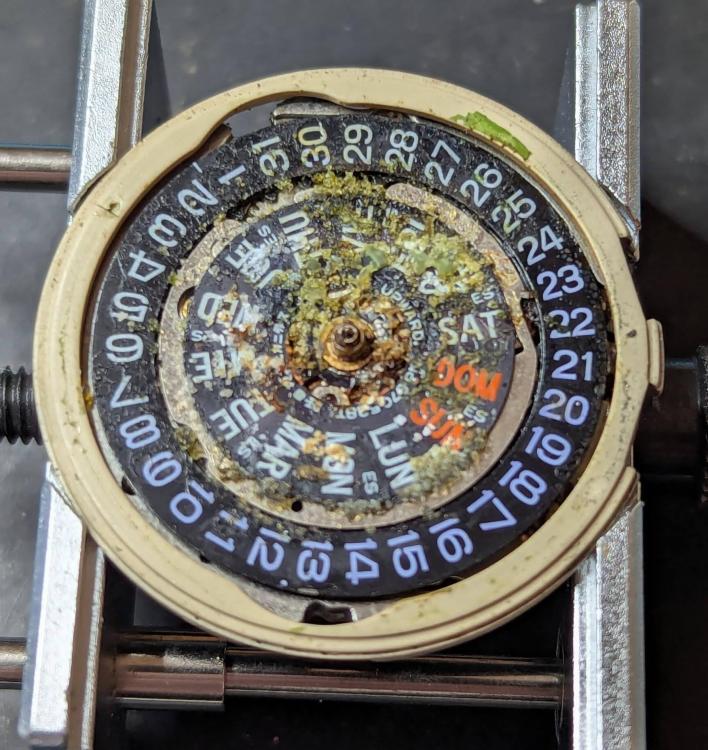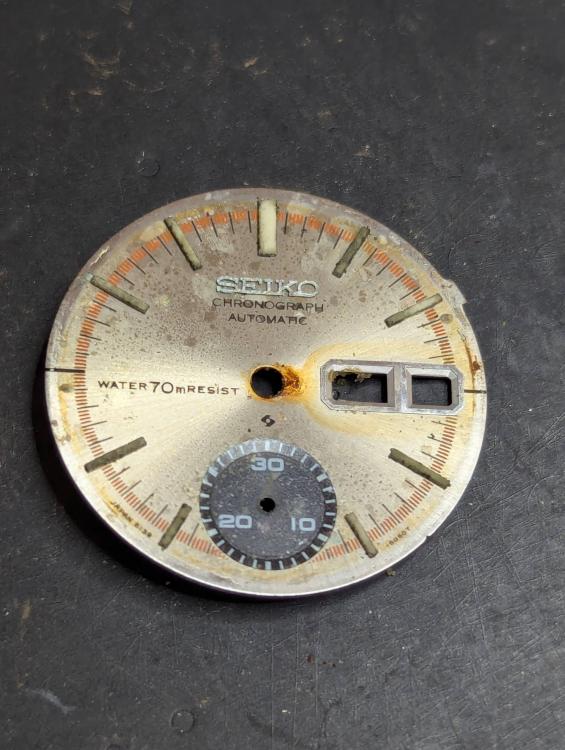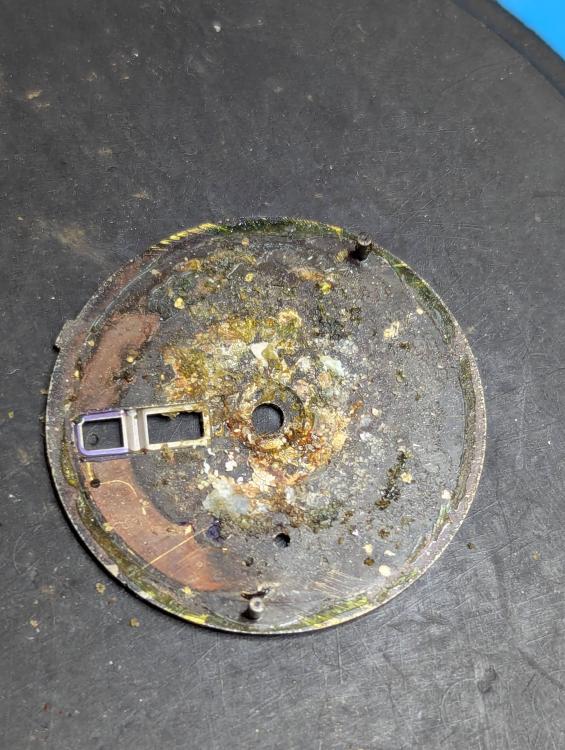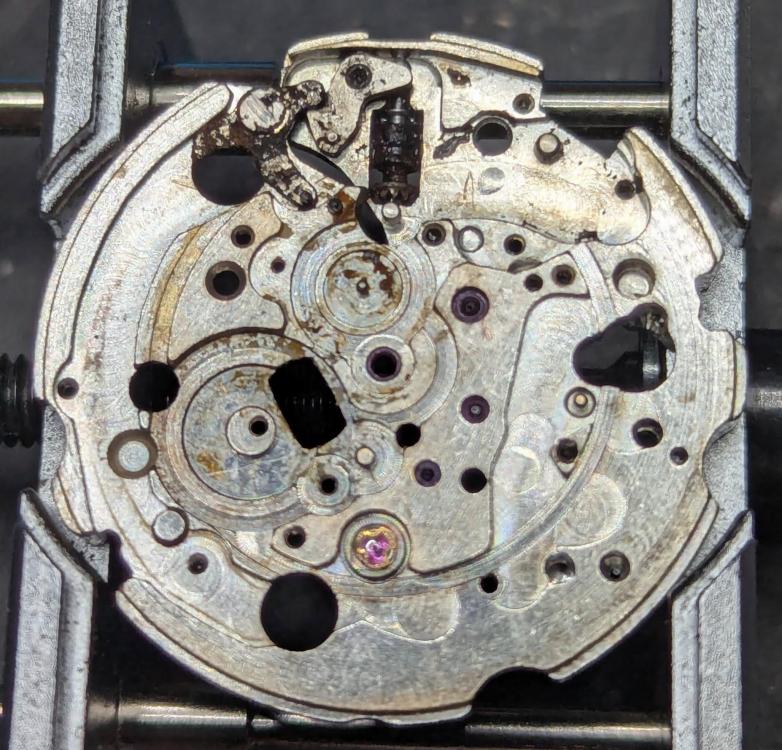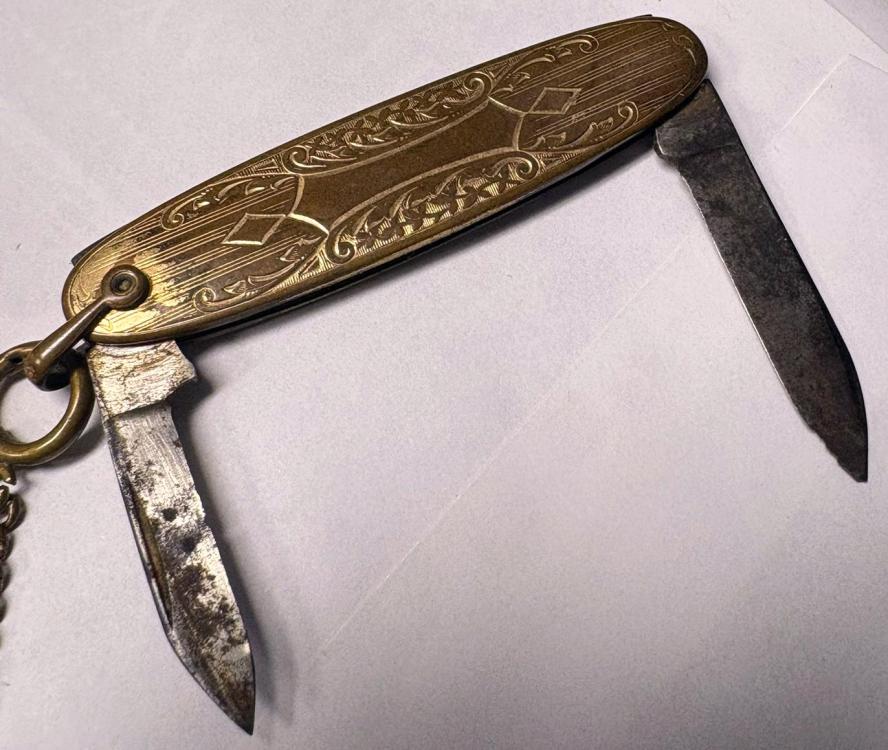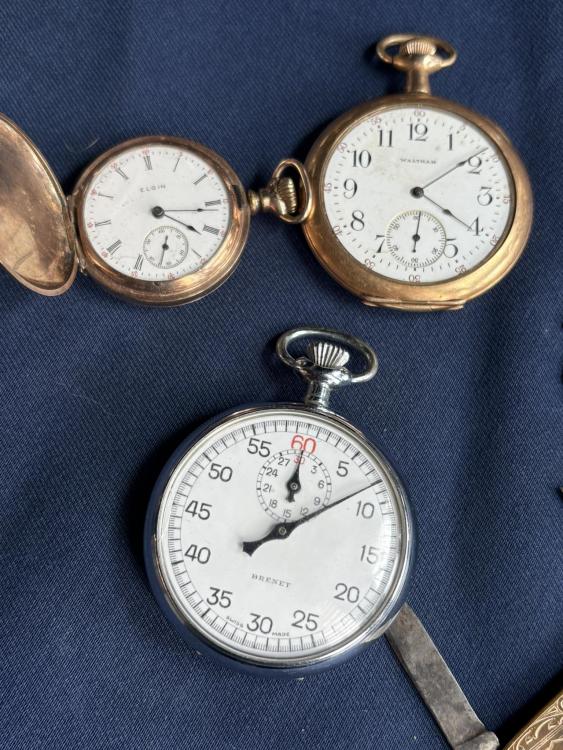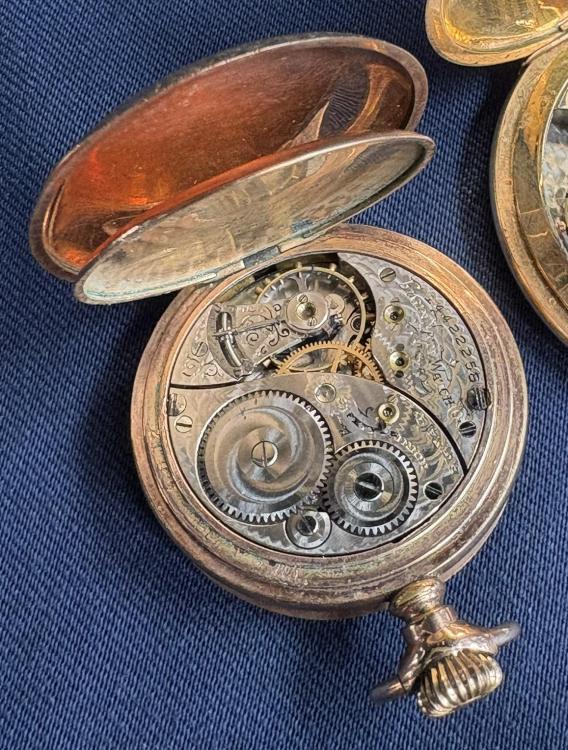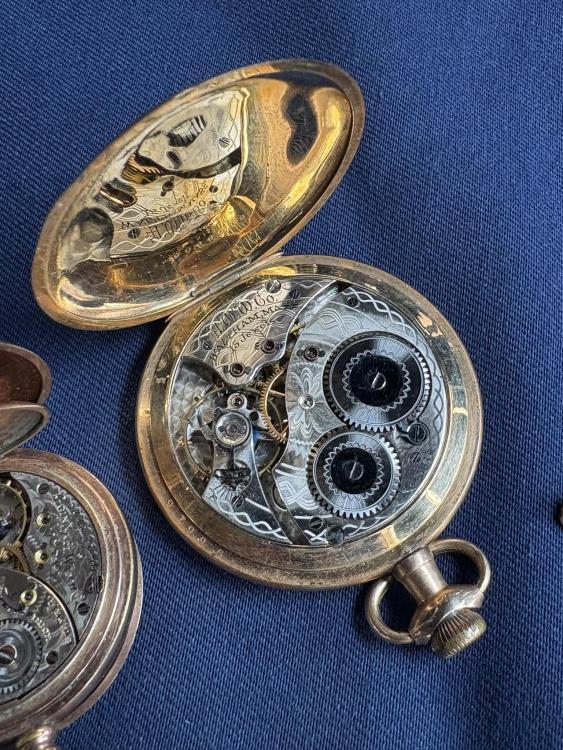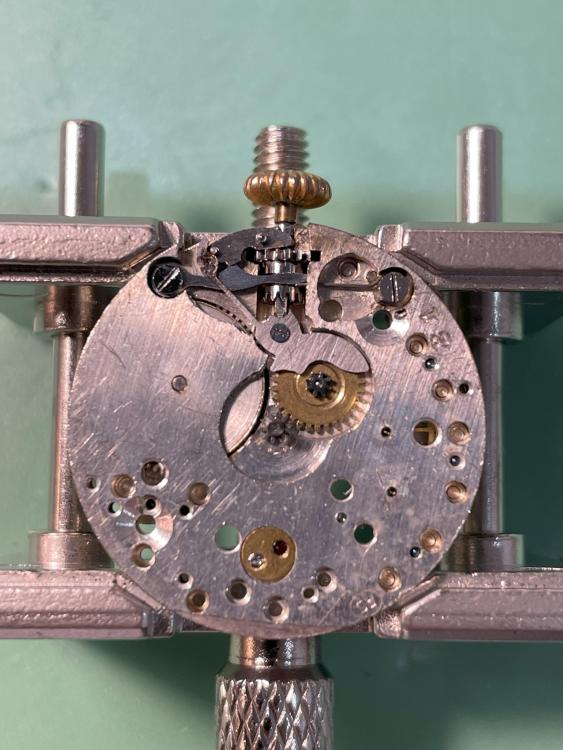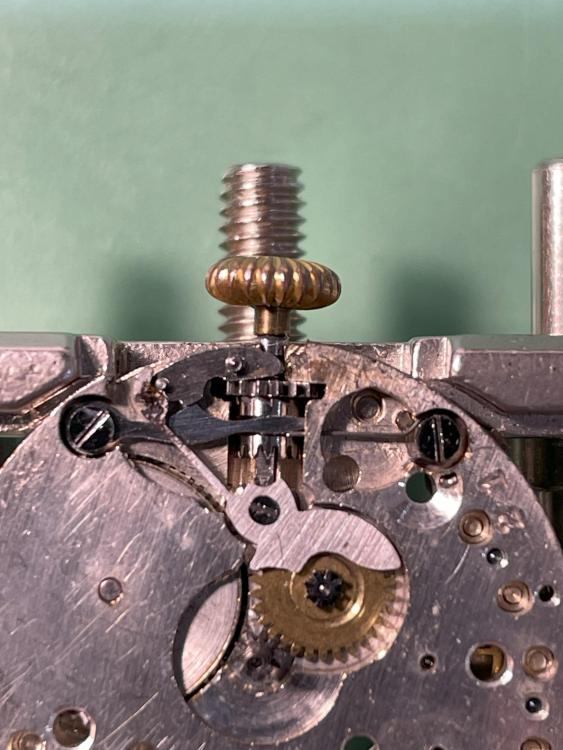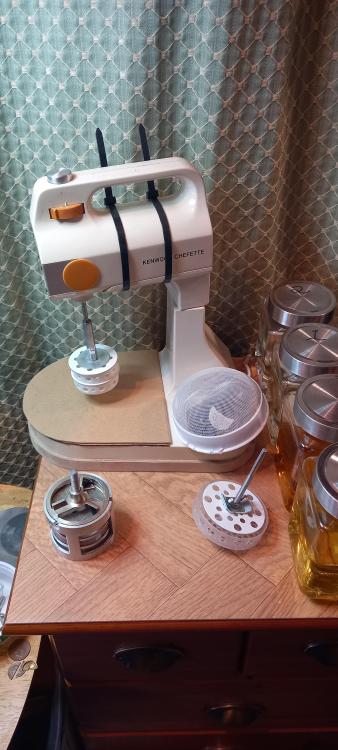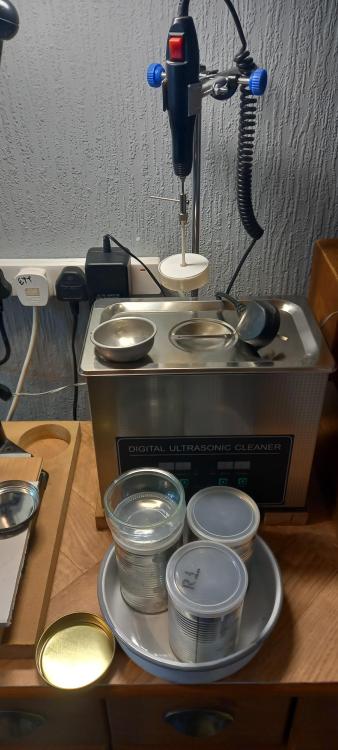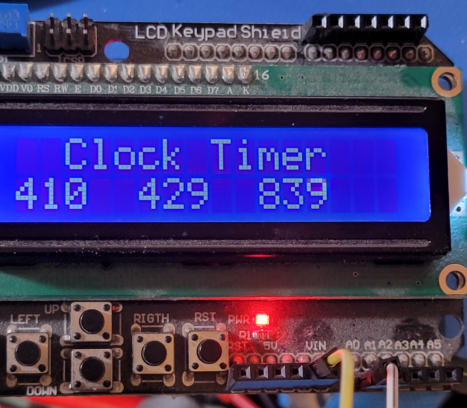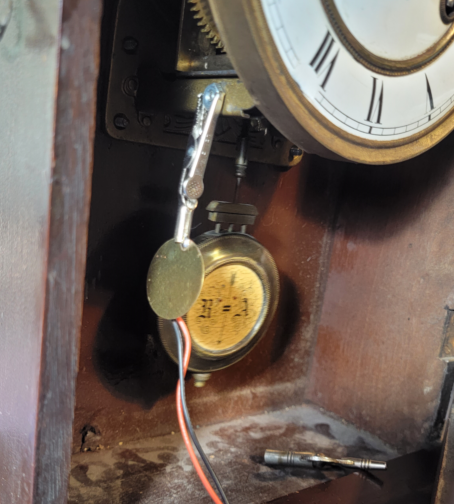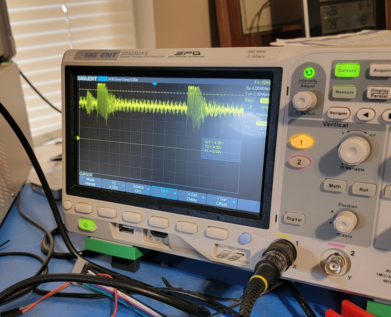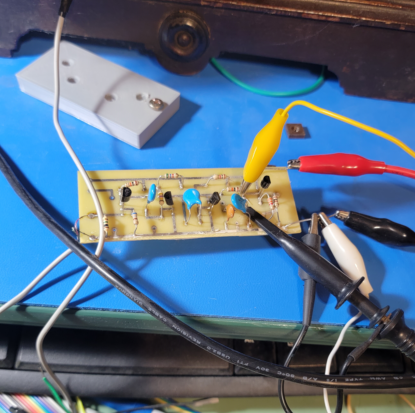Leaderboard
Popular Content
Showing content with the highest reputation on 04/14/25 in Posts
-
3 points
-
3 points
-
OK, I read the new posts diagonally... Now You have to regulate the axial free play and true the balance. The free play first: I would recommend to remove everything from the main plate and to put the balance cock only (no balance). But before that, if there are traces of 'repairs' like this then smooth and flatten all the surface under the cock or the cock bottom surface beforehand. Then fix the cock with it's screw and press it down on the stones area in order to bend it down a little. Then insert the balance and check the free play. You aim is to achieve what You call 'goldilocks' situation - there mus me almost no free play and the balance must turn absolutely free and all this without shimming. Of course, if the bending is too much, then You will use some lever to lift the cock or if the bending is not enough, repeat the pressing with more force. Now, the truing. The truing is truing in plain and truing in round. Truing in plain first. The main problem in compensating balances is that the rim is cut. Thus it has more freedom to take improper shape than the rim of 'regular' balances. The first distortion usually happens right with punching the old staff out. This make the balance arms bend where the hole is and this immediately brings the two halves of the rim to two different plains. So, the first thing to do if such thing happens is to immediately straighten the arms. Never use punches and hammering, do it just with hands. Then, similar bending may happen when riveting the staff. Again, straighten with hands only and try to bring the rim halves to one plain. Now, the real truing. I prefer to use this kind of tools. The left one is what we call 'eight, 8' in my language. It has no parallel jaws and only steel conical cup bearings. The idea of this tool is only to hold the balance and let it turn free. It is not used for bending the rim and arms, but only to rotate the balance and help visually find lo and hi places. There must be a pointer there, but I do without it pretty well. When You know where the lo (or high) point is, then You grasp the balance arm possibly closer to the staff with the pliers shown and bend in order to make the point higher (or lower). You bend only the arm which You hold. Bending may be lifting or lowering up/down or twisting, depending where the point is. Twisting is only the arm, not the arc with screws. If the arc is twisted in it's length, then it has to be untwisted in order entire arc to be in one plain. Thus You work on the one half of the rim only and when it is ready, work on the other half. Finally, You must have balance rim that rotates true in one plain. The main idea of not using truing calipers but such pliers is never to force the joint between the staff and the rim where the staff is riveted. This may be in a manner makes the work more complicated, but prevents from creating other problems.The pliers shown are prepared from long nose small pliers like this, which are usually sold in child/youth sets of 5. The jaws have to be annealed in order to be bent and shaped. Then truing in round is to be checked. If every person that have worked in the past on this balance did His work well, there should be no issues here. But, if truing is needed, then first try to understand where the problem is. It is needed to know if the arcs are bent or not. There is no logical reason for the arks to be bent unless someone did this without knowing what they do. If they are not distorted, bringing the rim to round should be done just by bending right where the arcs are connected to the arms. Otherwise bending may be needed in different points of the arcs. For this purpose the tool that @mbwatch describes is usually used3 points
-
Hope this helps: Pictures of three springs from my 4006 service/resto in 2023, both mainsprings have broken arbour eyelets ## As I said ended up using a 7 series mainspring which works okay: 4006 mainspring dimensions: GR2378X .95 high 1.2 thick 400 long 7 Series dimensions: GR2377X .95 high 1.1 thick 400 long Photo added here:3 points
-
Ok, I tried it and it worked! I performed the following steps: sawed through stem with diamond cutting wire, then I was able to remove the movement from the case disassembled the hands and the dial dipped the movement for 24h in Coca Cola rinsed in isopropyl alcohol ultrasonic cleaner with watch cleaning solution and then with distilled water dipped in benzine provisional drying After that I was able to disassemble almost everything from the movement, except the winding stem and two part of the keyless works. Some pictures from the process: Ready for sawing through the stem: After sawing the stem the movement was removed from the case: Removed the dial. What came out looked pretty horrifying to me The week day disk was crumbling and is totally destroyed: The dial front and back: The only parts remaining in the ground plate are for the moment the winding stem with gears and two parts of the keyless works: The winding stem does still cannot be removed. I will probably have to saw through the remaing part as well.2 points
-
I usually do this, especially on very dirty movements. I also peg the jewels at this stage. I do 4 mins in ultrasonic cleaning solution, then 2x 2 mins in rinses*, and 30s in IPA. That's for ALL parts including balance (attached to mainplate) and pallet fork. * I have Rinse 1 and Rinse 2 jars. When I change solutions, Rinse 2 becomes Rinse 1, and 2 gets new solution. The solution should be good for several watches. I use about about 200 ml of Elma (WF Pro cleaner, Suprol Rinse) solutions and clean about 5 watches before changing solutions. It is generally considered that 30 seconds is the recommended time for IPA. That way it's safe for parts using shellac - balance, pallets.2 points
-
At least you shouldn't have any problems getting replacement parts.1 point
-
@JohnR725 I really appreciate your help, I just started using Elma Red after some years of solvent based solutions. I would use the solution for one or two cycles a week, and I really don't mind changing the fluid often since I have a local supplier who sells it, and the volume needed is not big. I should have read the guide of the product before asking, somehow I didn't even think about that. So, I guess that: 1.- I can reuse the solution as long as It does look clean and bright and I change it regularly, lest say 3-4 watches and no longer that lest say a month. 2.- I should add at least one more rinse with distilled water. 3.- It seems safe to clean balance and pallet fork in ultrasonic bath with Elma Red. 4.- Final rinse just 30 seconds in IPA. 5.- Better dissolve Elma Red with distilled water. I hope I understood right. Thank you a lot.1 point
-
An interesting side note to this, we are told not to use Alcohol based solutions on anything with Shellac on ie Pallet fork and roller table as the Alcohol softens the Shellac and many promote the use of solutions that contain ammonia which is supposed to be safe for Shellac. One of my other hobbies is wood turning and in that we use Shellac quite a bit and in the wood turning community what do we use to clean our brushes after applying Shellac, no not Alcohol but Ammonia. So I do wonder just how safe our Ammoniated solutions really are? Perhaps waterbased cleaners and a quick drying cycle is not such a bad option after all1 point
-
a solvent-based cleaner versus the original question of the water-based cleaner? you didn't specify a time frame for when you're going to reuse your water-based cleaner? In other words weeks months years later you going to use it again might be a problem if it starts to evaporate but I doubt it's going to go bad instantaneously. Although even though I believe it uses the word tap water for mixing with the cleaner I would use something that's not tap water it depends upon where you live as there may be all sorts of undesirable chemicals in the water. then looking at the PDF of the product use guide there is an indication of this Should the solution become cloudy after prolonged use, the cleaning effect might be reduced. Prepare a fresh cleaning solution this does give the impression that it can be used multiple times it would seem rather strange that the solution only has a one time use. the actual description of watch cleaning is usually different than what people think. In the case of a solvent-based cleaner with a solvent itself will put things in solution like oils there other additives that speed that up plus make things right and shiny. Then the rinse especially when solvent-based will continue to remove things from the watch such as oils so it actually will continue to clean. The second thing that the rinse does its primary thing is to reduce the concentration of cleaning fluid on the watch itself. In other words you put all the bad stuff in solution and the solution is now covering your watch. So ideally should have more than one rinse to remove that bad concentration a stuff from the plates. if you look at modern Elma cleaning machines that used water-based cleaner will notice that they do have four separate jars. With three of them listed as rinse. They do have another machine that's very very nice and exotic but it can't used water-based cleaner but it still does have four containers. Whereas older cleaning machines typically only have three jars. even Elma recommends IPA on their exotic cleaning machine because the rinse doesn't like to evaporate on a timely basis. So yes now it seems he is standard practice to use alcohol as the final final rinse if you want things to drive properly. I always find this a really interesting question. When I was in school learning watch repair we didn't have any restrictions in fact it was never even mentioned at all. Then if you look at the Elma cleaning solutions for watches I've never seen a restriction on do not put balance wheel and pallet fork in our solution. otherwise if there was a restriction they would make special cleaning products just for balance wheels and pallet forks conceivably even then making a special cleaning machine. Which definitely would not go over well considering how cheap watchmakers are to have to have two separate cleaning machines and fluids so as far as I know there is no restriction. Then especially with anything vintage it's always best to check the shellac on the pallet fork and definitely on the roller jewel as somebody before you might not of used shellac or the quality the shellac disintegrated with time etc. as often times whatever was there before will go bad. Having a loose roller jewel does not make for good running watch at all.1 point
-
usually all these nifty electronic devices have speakers. Typically speakers have magnets and because they really tiny speakers they typically have really strong magnets to make up for the period then how bad is the magnet situation I went googling and this link was interesting https://www.fda.gov/radiation-emitting-products/cell-phones/magnets-cell-phones-and-smart-watches-may-affect-pacemakers-and-other-implanted-medical-devices one of the problems with using apps is the lack of a proper pick up of your watch. Because it doesn't have the right type of a pickup it's instead listing for audio it sometimes does not interpret things correctly. Then fun is not what happens when people bring the results to the discussion group and think their watches having a problem when maybe in real life it is not. In other words it's not fun to diagnose a nonexistent problem.1 point
-
1 point
-
Not in the mail, but I happened to be at my local jeweler, who lets me rummage around in his case of estate sale and broken watches. Found a few nice little guys to play with. First this Waltham. Missing the crystal and looks like it may have a broken balance pivot, but gorgeous otherwise. S/N 19182492 puts it at 1913. The case is marked Dueber, 9096616. Then this lovely little Elgin. S/N 14422258, dating it to 1909! Officially the oldest watch I own. Case is also Dueber, 7614612. The balance seems okay on this one, but it's sluggish. Hopefully just needs a service. I had to throw in this stopwatch and sweet Deco watch fob while I was at it.1 point
-
Just ordered a cantilever toolbox to keep my polishing items in. Photos to follow. Used mops etc are going to be bagged and labeled with the compound used.1 point
-
1 point
-
Hi, welcome. Could you show where the missing screw is from? Since you have a for "parts and craft" bin, you could search for a suitable donor screw.1 point
-
I think the type with a thumb screw in the middle where the two jaws stay parallel are the best, easiest and safest to use. If you can find one that comes with the little balance rim wrench, all the better though you can get by without it. A lot of them are incomplete so you have to make sure it has the adjustable pointed blade attached, that is placed just very close to the balance rim so you can judge by eye the comparatively high and low spots. But that piece is frequently missing. Levin made one that looks pretty much the same as the Vigor model pictured, that is really nice. Other types that you open and close jaws without the thumb screw in the middle that open and close like scissors are a little harder to use.1 point
-
I asked the same question on 'Seiko Mod' Facebook page, general opinion was 'your watch stops because the hands touch the glass'. So, I trimmed the seconds hand by about 5mm, aligned it to be a lot close to the second hand, and gavethe central pinion bit an extra press, squash the seconds hand down. Works a treat winner1 point
-
For completeness, this build had a happy ending. As nevenbekriev said, once the pressure was off and I finally gleaned that it was a left-hand thread I was able to remove the sheared-off bit of screw in the barrel arbor. Found another left-hand screw in one of my old movements, and hey-presto, the mainspring was all back together. As for the broken setting lever spring, I couldn't find any movement parts for the AS 415 family, or the AS 521 specifically as this appears to be. However it turns out that this is the same setting lever spring used in the AS 340 (I was also doing up one of these at the same time so it was a completely lucky coincidence). I was able to source another battered old AS 340, got the setting lever spring out of it, fitted it to my AS 521, and happy days. Pictures show it in place. A little tarnished but working fine. Movement is now all back together and running very sweetly. Thank you all for your help. Appreciated.1 point
-
The basket in the photos holds 5 mini mesh baskets. Others carry 7 and a double decker one will manage 8 then a Pearl / Elma copy is used for a more pieced movement...all of them fit or can be adapted to fit with thread reducers the drill press or the kitchen mixer.... and last is another dc motor suspended over the ultrasonic which also runs from the motor programmer, the metal bowl i float in the US and will carry a balance, a hairspring or a pallet fork This just covers all my bases. I'm done with cleaning machines now, i think I've built 6 in total......mk 6 works lovely it just needs a little tarting up1 point
-
There should be a pinned post on alcohol. For many years my cleaning machine was a brilliant machine made by Greiner. First bath, water based cleaner, ultrasonic, fluid agitated by pump running through a filter (magnet in filter too!). Second bath is isopropyl alcohol. The way the "baskets" were set up the fork and balance were on their own set. They went in for 30s, then to hot air stream. The rest of the movement went in, 30s later push a button and the alcohol emptys into the built in distiller, and 6m later the bath is flowing (another circulating pump) with clean alcohol. Great setup. Sometimes I'd forget a fork in the alcohol for 30m or so, usually OK, sometimes it did strip the shellac. No biggie, reapply shellac. 99/100 or even more often the stones are a light friction fit so haven't moved. Most roller jewels younger than 60-70 years old are also frictioned, with a bit of shellac. In 15+ years one roller jewel came out of a 110+ year old watch, definitely because I left it in for at least an hour (and the alcohol is quite warm, coming from the distiller). The jewel was found in the filter for the distiller- yes another filter. Greiner made great stuff. Last century I learned very quickly that iso alcohol is sloooow to dissolve shellac. Ethanol, way quicker, and heated ethanol, way way quicker. Back then if I wanted to move pallet stones I usually stripped all the shellac, got them positioned, the reshellaced. Nowadays I do it with the original shellac in place. But if I was out of ethanol, it was a tedious process to remove with iso. I await 5 weeks from now when a new discussion on alcohol, the different types, and shellac comes up again. 2 weeks? As for French polish, most folks use some form of ethanol, either pure or denatured. It dissolves shellac so much better and faster. But I've read of folks using 99% iso too. There's probably woodworking forums with never ending discussion of this too. But as a pro, with 25+ years in, I can say isopropyl is crap at dissolving shellac, ethanol is great.1 point
-
1 point
-
"Rancid" is when the hydrocarbon chains break, and the resulting free fatty acids bind with oxygen to form aromatic compounds that smell bad and are able to accumulate in sufficient concentration that you can smell them. Beyond that, Oils is oils (this excludes any mineral derived oils, different thing entirely). Hydrocarbon chains of varying lengths with varying degrees of saturation. Olive oil is 18 carbon bonds, and is partially saturated. Linseed oil is 16, pretty thoroughly unsaturated, and the free fatty acids like to form polymers when oxydized. Chemistry mumbo jumbo aside, there's nothing special about olive oil that makes it for cooking or vice versa. Olive oil is medium length, relatively saturated, and non-drying. It was traditionally used in all sorts of things that wanted oil that didn't dry, such as leather treatment, wood finishing, etc. I use it routinely for French polishing for example, as well as maintaining my vegetable tanned leather. I have also used it to cut beeswax for wood/leather treatment in the same manner. It's a good, readily available, middle of the road oil without any major drawbacks. Waxes are like oils, but even longer, and fully saturated carbon chains. Martyd's recipe is another good one. The carnuba wax is fairly modern, but turpentine evaporates more quickly and would have been common prior to the rise of "better living through chemistry" in the latter half of the 20th century. You could do turpentine and beeswax as a finish to split the chronological difference.1 point
-
As a cabinetmaker, I have made a couple of long cases to house recovered movements and my recommendation is ,as above, to use a beeswax polish. We have a saying on polishing wood with beeswax: once a day for a week, once a week for a month, once a month for a year. This is how very old tables and furniture have built up beautiful deep finishes over the years.1 point
-
Whatever you do, don't use Lemon Pledge. That contains some synthetic stuff that gives the wood a "moldy" appearance after a year when it dries up. And the only way to get rid of the moldy look is to apply another coat of Pledge. It's horrible. Personally, I use Howard's Feed n Wax now after learning it the hard way. https://www.howardproducts.com/product/feed-n-wax-wood-polish-and-conditioner/ But I'm curious as to what professional clockmakers use. Renaissance Wax? $$$1 point



